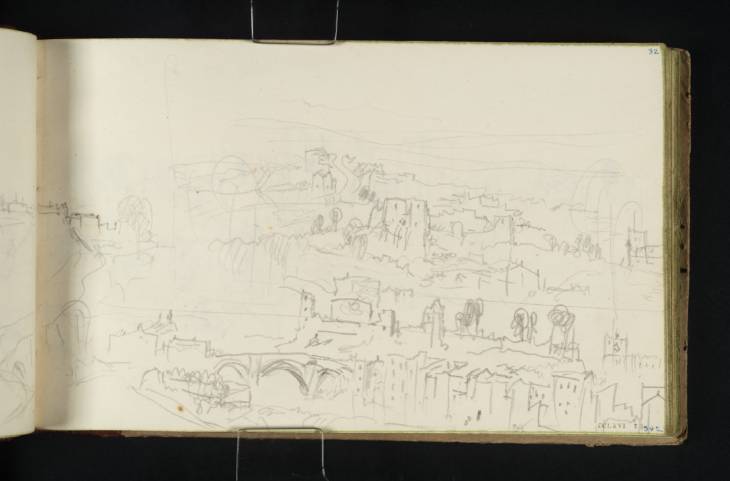Joseph Mallord William Turner Barnard Castle 1831
Joseph Mallord William Turner,
Barnard Castle
1831
Joseph Mallord William Turner 1775–1851
Folio 32 Recto:
Barnard Castle 1831
D25823
Turner Bequest CCLXVI 32
Turner Bequest CCLXVI 32
Pencil on white wove paper, 114 x 187 mm
Inscribed in blue ink by John Ruskin ‘32’ top right, and ‘342’ bottom right
Stamped in black ‘CCLXVI 32’ bottom right
Inscribed in blue ink by John Ruskin ‘32’ top right, and ‘342’ bottom right
Stamped in black ‘CCLXVI 32’ bottom right
Accepted by the nation as part of the Turner Bequest 1856
References
1909
A.J. Finberg, A Complete Inventory of the Drawings of the Turner Bequest, London 1909, vol.II, p.855, as CCLXVI 32, as ‘Barnard Castle.’.
1999
Peter Bower, Turner’s Later Papers: A Study of the Manufacture, Selection and Use of his Drawing Papers 1820–1851, exhibition catalogue, Tate Gallery, London 1999, p.54 fig.25B reproduced as ‘Micrograph of the paper surface of TB CCLXVI 32 at x 15 magnification’.
1996
David Hill, Turner in the North: A Tour through Derbyshire, Yorkshire, Durham, Northumberland, the Scottish Borders, the Lake District, Lancashire and Lincolnshire in the Year 1797, New Haven and London 1996, pp.48, 191 under ‘XXXIV 29’, 199 note 69.
Although Barnard Castle was not illustrated for Sir Walter Scott’s Poetical Works, it had been proposed by Scott and was included in the list of subjects sent to Turner around 1 April,1 and had featured as a setting for one of Scott’s poems, ‘Marmion’, 1808. Turner passed the castle on his way between Rokeby (where he went to see the junction of the Greta and the Tees) and Bowes Castle, both of which were sketched for illustrations to Scott’s poetry.
This was Turner’s third visit to the castle. He saw it first in 1797, and then again in 1816 in connection to Whitaker’s History of Yorkshire. In the late 1820s Turner made his only painting of the castle for the Picturesque Views in England and Wales: Barnard Castle circa 1825 (watercolour, body colour, pen and ink, Yale Center for British Art).2
There are four pages of sketches of Barnard Castle in this sketchbook, starting with two views on the present page. Both were taken from the south, though the castle appears quite differently in each. The sketch on the upper half of the page was made from directly south of the castle on the eastern side of the River Tees within the castle grounds. At the far right of the sketch is part of St Mary’s Church, and the castle is in the centre of the sketch with its cylindrical tower and northern curtain wall being the most prominent features. The river is shown above the castle.
The sketch at the lower half of the page was made from the western bank of the Tees just to the south of the castle. Along the eastern banks are a row of tightly packed houses which no longer stand, above which are the castle and St Mary’s Church. The River Tees traditionally divided County Durham and Yorkshire, so that the castle bridge connected the two counties. Although the bridge appears to have three arches in this picture, it in fact has only two, the rightmost being a blind arch at a forty-five-degree angle to the length of the bridge, which supports a widening of the bridge as it meets Bridge Gate.
At the left of the page is the continuation of the sketch of Bowes Castle on folio 31 verso (D25822), here showing the east side of the town of Bowes and the road between Bowes and Gilmonby. There are further sketches of Barnard Castle on folios 32 verso, 33 and 34 of this sketchbook (D25824, D25825, D25827), and in the Rokeby and Appleby sketchbook (Tate D25628; Turner Bequest CCLXIV 55a).
Thomas Ardill
September 2009
How to cite
Thomas Ardill, ‘Barnard Castle 1831 by Joseph Mallord William Turner’, catalogue entry, September 2009, in David Blayney Brown (ed.), J.M.W. Turner: Sketchbooks, Drawings and Watercolours, Tate Research Publication, December 2012, https://www

